If you have a website, a topical map is key to SEO success. Think of topical maps as content plans on steroids. In fact, topical maps are the standard now when it comes to content planning.
A well-structured, proper topical map can transform your site into an information hub that search engines love and keep readers coming back for more. With all the AI-generated content and sites that are spun up every day, you need to stand out.
Following the AI strategy of publishing a bunch of content from a list with no topical hierarchy or organization will put your site in the same (sinking) boat.
Don’t capsize your site just because of a scattered approach to keyword research and unorganized lists of topics.
I’m going to walk you through creating topical maps the right way, so you know what you need. Topical mapping is an art and can help take your SEO game to the next level.
Let’s get mapping…
How to Create a Topical Map TL;DR Overview
Since this is what you’re here for, here are key steps to creating a great topical maps:
- Research and Break Down Your Core Topic: Starting with your core topic, create a topical outline that includes main topics and subtopics.
- Keyword Research and Clustering: Using your main topics and subtopics, get all the relevant keywords. Filter out irrelevant topics and keywords as you go to only keep the ones that matter to you and your audience. Cluster the relevant keywords according to the SERPs. This is where most people stop – BUT you’re going to keep going.
- Topical Hierarchy and Internal Linking Strategy: Organize and shape the structure of the the keyword clusters to create a logical hierarchy from broad to narrow topics. Implement an internal linking plan that reflects the topical hierarchy.
- Visualize the Topical Map: Topical map is done now and consists of a spreadsheet and mind map to show off all that hard work put in.
- Track Your Content and Maintain Topical Map: Monitor the topical map to track your published content’s performance. Look for opportunities to optimize or adjust your strategy. A strong topical map, supported by continuous analysis and updates, is a powerful tool for boosting your SEO and keeping your content fresh and relevant.
Those are the basic steps. Now, time to dig in a little more.
Why Topical Maps are Essential for SEO Success
Topical maps are the secret sauce for successful SEO and digital marketing campaigns.
A good topical map neatly arranges your website’s content like a high-tech library. Think of it as the 21st century Dewey Decimal System. This system guides both search engine crawlers and your readers through your site with ease.
When your site has a clear and well-structured topical map, it’s like rolling out the red carpet for search engines. They can navigate your site better, which improves your rankings. Plus, a tidy topical map is a win for user experience. Visitors find what they need quickly, making them more likely to stick around and explore.
If your site is hard to navigate for search engine crawlers, you think they’ll want to come back often? They’re going to spend more server resources to crawl your site. Unless you’re one of the digital media giants, they’re not going to spend their time and money trying to figure out your site.
With constant advancements in machine learning and semantic SEO, search engines understand sites and content context better and faster. This means having a strong topical map is more critical than ever. It helps search engines connect the dots between your content, making your site more visible to relevant searches.
The evolution of search engine algorithms and Knowledge Graphs, means they now prefer sites with clear topical maps and structure. This preference is because organized sites are easier to index and serve up in response to search queries.
How to Identify Main Topics and Subtopics for Your Topical Map
All topical maps start with laying the foundation of main topics and subtopics for your core topic. Depending on who you follow, there are a number of names for the core topic – seed, central theme, source context, site purpose, and any other other number of technical terms people throw out there.
Your core topic directly depends on your business and its goals. Depending on the size of your business, you could even have multiple core topics and nested topical maps.
Let’s say you have an ecommerce business selling shoes. You could have multiple core topics here because of the breadth of shoes available. To create one topical map to cover everything in one sitting is impossible. You’d need multiple maps if you a company like Zappos.
The organization of nested topics and maps are where the scalability of topical maps really shine. Putting in time in the beginning to properly plan and organize your topics will allow you to scale quickly in the future.
Here are screenshots of Google searches using the ‘site:’ operator to roughly see how many pages are showing up for different types of shoes:
- site:zappos.com – 1.94m results
- ‘athletic shoes‘ – 615k results
- ‘golf shoes‘ – 245k results
- ‘running shoes‘ – 600k results
- ‘women’s shoes‘ – 1.72m results
You could say it’s an ecommerce site, so they have many products and many SKUs. I’ll give you that.




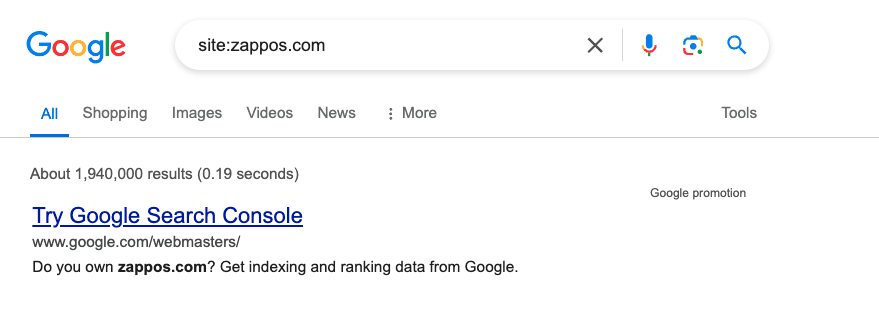
Then here’s CNET.com, 4.03m results.
Here’s a smaller one: NerdWallet.com with 70.1k results.


So when it comes to picking your core topics and where to start breaking down into your main topics and subtopics, you need to look at your business and goals first.
Think about how broad or narrow you want to start. Look at your competitors and see what they already have for because that’s also going to drive what you need to have in your topical maps.
Brainstorming your core topics, and breaking them down into main topics and subtopics is a creative process. It’s a balance of what Google understands the taxonomy of your industry or niche to be, your business and site’s goals, and your SEO expert’s ability to balance it all.
You can go to all sorts of places to research topics and one of the best places is Google itself. Google’s Knowledge Panels and SERP features are some of the best places.
If your search query is ‘athletic shoes’, you can see all the various filters and headers that Google gives you. The way they organize athletic shoes from their filter categories is a great start to organizing your own main topics and subtopics depending on your site’s goals.
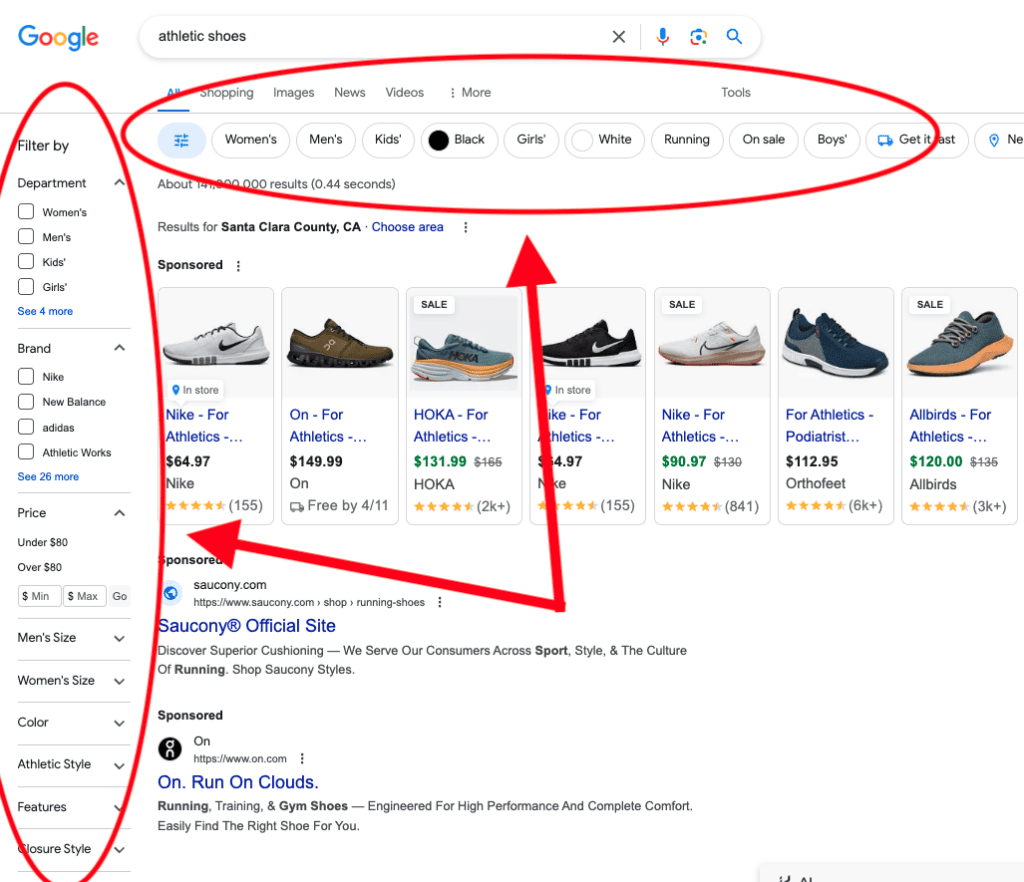
Choosing the right topics and subtopics for your website is like laying the foundation for a strong SEO strategy. If you don’t consider the business side with your target audience’s expectations, you’re starting from way behind.
Researching and Clustering Your Keywords
After establishing the main topics and subtopics, the next step in creating a topical map is keyword research and clustering.
The keyword research process is all about identifying the specific keywords that your target audience uses when searching for information related to your topics.
- Use tools like Google Keyword Planner, LowFruits, Ahrefs, Semrush, Google Search, etc.
- Search forums, social media, competitor sites, and other places your target audience hangs out.
- Gather up all the keywords and then filter through them for relevancy.
- The keyword research and filtering process will usually take the longest time.
To save time, you could do things like removing keywords with low search volume, but you’d be missing out on golden opportunities, especially if they have 0 volume because it’s something new in the market.
You could also do things like removing keywords with high search volume and super competitive that only the big sites are ranking on Page 1 for. But then you’d be missing out on creating content for key topics that are very relevant.
Part of being a topical authority is to show your audience your brand has complete topical knowledge in your space. That space can be small or large, so that’s why the previous step of figuring out the core topic for your business is so important.
Once you have your filtered research, you put them into a tool like LowFruits or KeywordInsights to cluster them according to the SERPs. They had the best accuracy the last time I tested 13 different keyword clustering tools.
- If you’re a Topical Maps Unlocked student, you get a special discount. Log in to get the code.
By analyzing search engine results pages (SERPs), you can see all the unique topics to write articles for. Along with the search intent, the SERP analysis helps you validate which clusters of keywords are worth targeting. You get additional understanding of the competitive landscape and content gaps that your website and business can fill.
The SERPs help you align your topical map with user expectations and search engine requirements.
By following these steps, you’ll build a solid foundation for your content strategy. This approach ensures your content is not only optimized for search but also well-structured to meet your audience’s needs.
Now, this is where the majority of people stop. They have their list of topics (keyword clusters) and they start writing.
There’s a big problem with that. How do all the topics fit together?
Crafting a Topical Hierarchy and Internal Links
After the keyword clustering, you could have hundreds to thousands of unique topics. You need to figure out the topical hierarchy that will guide your writing process and content hierarchy.
If you think about being in school and learning any subject, wasn’t there a structured process to learning? When you broke down your core topics into main topics and subtopics, wasn’t there a process of going from broad to specific topics?
That’s how your topics and content should be organized too. They should be organized hierarchically up to 4 levels deep. I’ve seen that it’s been the best balance of click depth. It’s not too deep where the content feels hidden, but also not so shallow that there’s no structure.
Many people use different words like pillars, supporting pages, hubs, spokes for how to organize content – I just keep it simple.
- Main Topic – Broadest topics. Click depth of 1.
- Subtopic 2 – More specific topics.
- Subtopic 3 – More specific topics.
- Subtopic 4 – Most specific topics. Click depth of 4.
Doesn’t get much easier than that. 4 levels of hierarchy and 4 clear labels. Your goal is to figure out what content to create and to go create it in a structured way.
Other approaches like pillars and supporting pages or hubs and spokes are useful, but only serve up two levels. Your content would lack topical depth because you’re only serving up two levels of topics. Even a basic labeling system of beginner, intermediate, and advanced has three levels.
Here’s a comparison of three different structures:
- Keyword Clusters: A flat, one-level site architecture with just a list of keyword clusters.
- Topic Clusters: Two levels with pillars and supporting pages.
- Topical Map: Up to four levels of topical hierarchy.
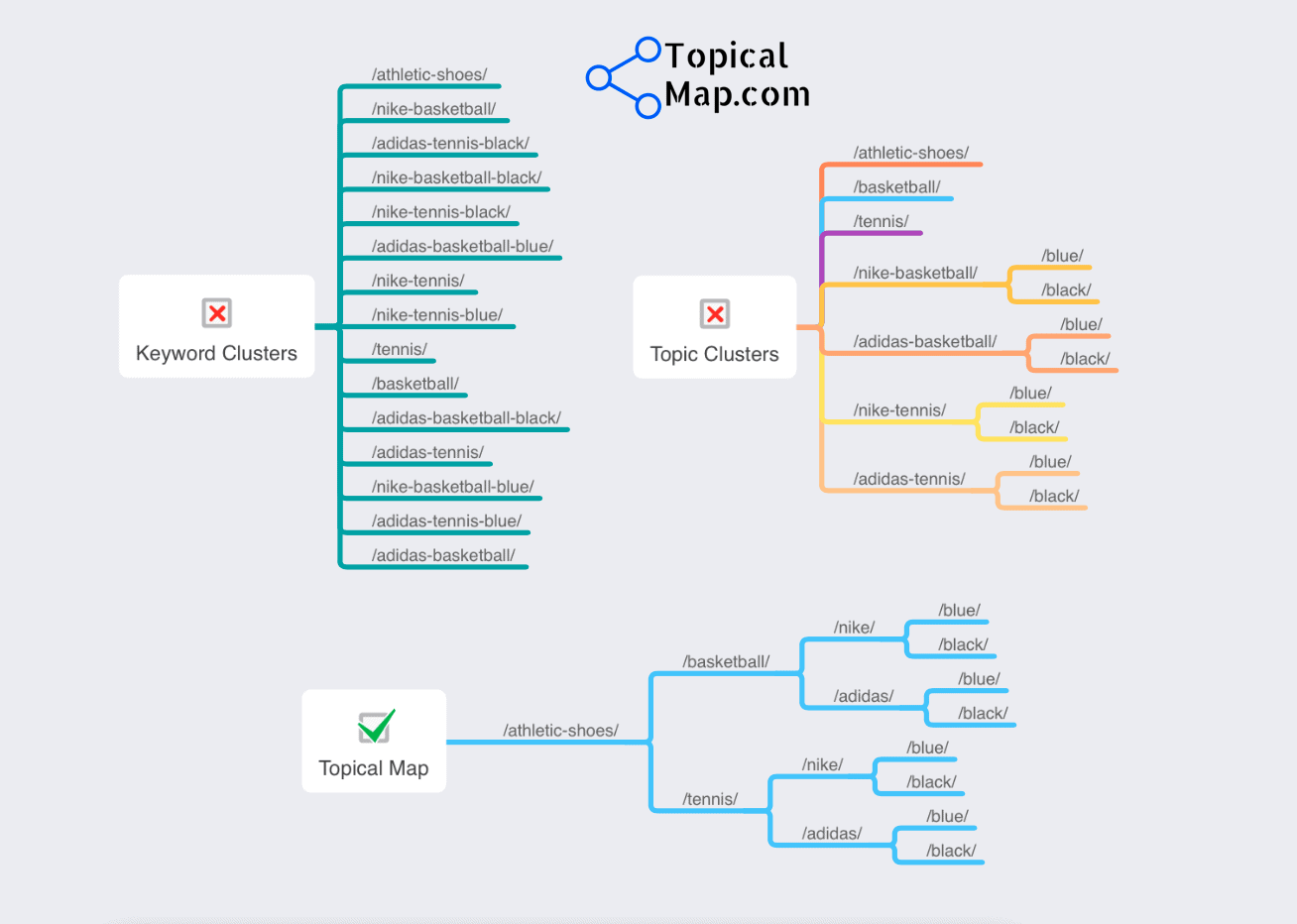
However, I do want to note that not all topical maps need to be broken down into 4 levels. It depends on if you’re creating a nested topical map within a larger one, which would be 4 levels.
Clients often come to us to create a topical map for a specific area of their business, so we know going in, we can’t use 4 levels of hierarchy. We can only possibly use 3 levels, because one level is already taken. So it has to all fit seamlessly into their current business goals and site structure.
As you see, the topical hierarchy guides your internal links because of the organization of broad and specific topics. It reinforces the semantic relationships between pages.
Any user or search engine bot crawling your site can easily explore your site and see that you understand the space well. You understand what’s broad, what’s specific, and how all the topics fit together through the internal links.
Visualizing Your Topical Map
Once you have your topical hierarchy organized, your topical map is essentially done. There are two main ways to view a topical map – spreadsheets and mind maps.
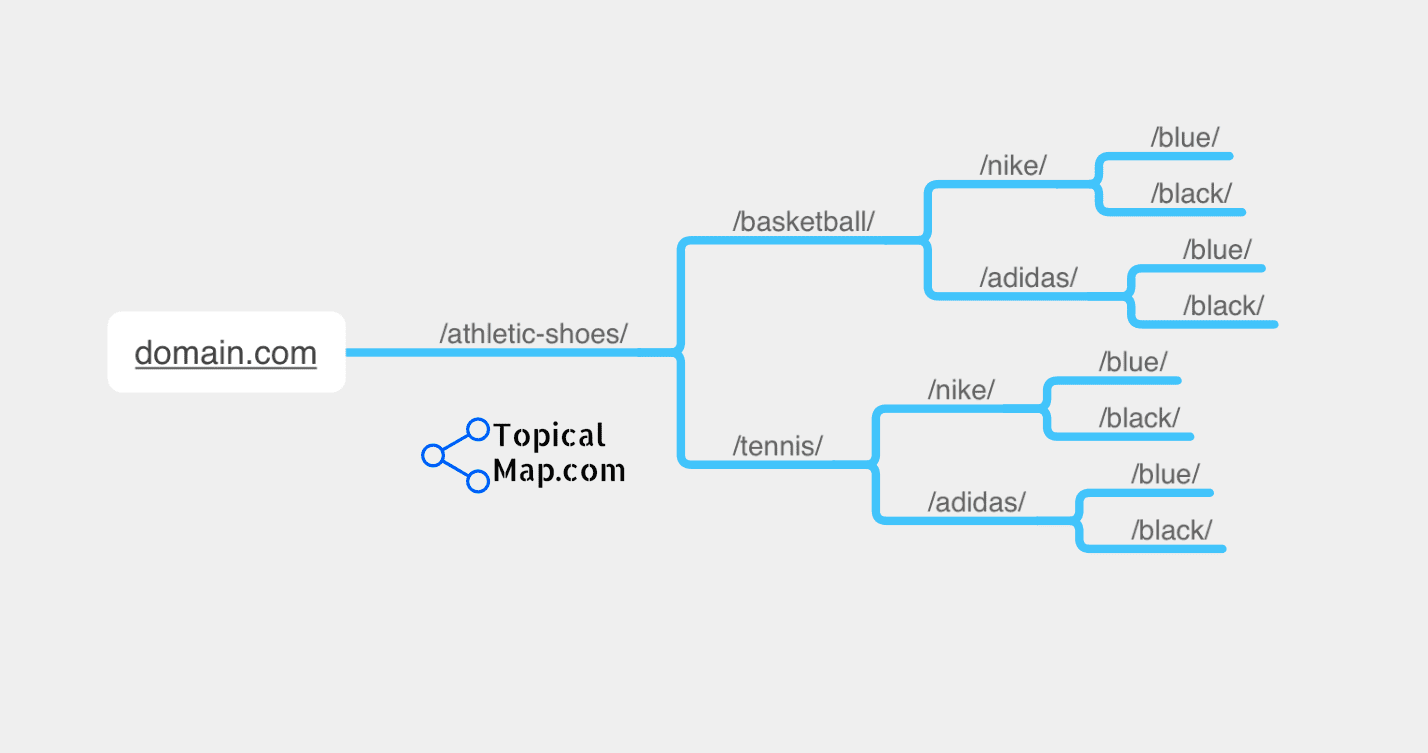
I love a good spreadsheet, but I also love my more visual mind maps. They provide the same topical hierarchy information, but also has slightly different uses:
- Spreadsheet – This acts as a content management sheet too with my editors and writers. We’re able to see what the status is for each piece of content, along with anchor text, SERP analysis, and much more information.
- Mind Map – This is more visual and easier to see the connection between topics and understand the hierarchy of the topics. It doesn’t have the depth of information of the spreadsheet, but it’s a prettier way to see what’s been published and what still needs to be created.
The main tools I use for each are free and freemium.
- Spreadsheet Tools – Google Sheets is perfect here and completely free. Excel is good too if you prefer a desktop app or have large sheets that are 30k rows or more.
- Mind Maps Tools – Mindnode (Mac-only) and Xmind.app (Mac and PC) are both freemium. The free versions are more than enough.
We have a partial topical map example on spiral stairs for a stair manufacturer.
Monitoring, Evaluation, and Maintenance of Your Topical Map
Like any SEO strategy, a topical map is not a set-it-and-forget-it component. To truly succeed, it requires regular monitoring, evaluation, and updates to remain effective.
This ensures your website stays relevant to both your audience and search engines. Here’s how to maintain your topical map for ongoing SEO success:
- Regularly Review: Keep an eye on industry trends and changes in how people search for information. This will help you adjust your content strategy to meet evolving needs. Look for new places your target audience is hanging out.
- Analyze Your Data: Use analytics to see how well your topical map is performing. Look for areas of improvement, such as high bounce rates or low engagement.
- Listen to Feedback: Pay attention to user feedback. It can reveal gaps in your content and opportunities for growth. With Google’s UGC love, might not be a bad idea to open up your comments.
- Update Your Content: Don’t be afraid to update or expand your existing content. This shows search engines that you’re actively maintaining your site and can improve your rankings.
- Follow SERP Changes: Search engine algorithms are constantly changing based on search intent, so keep an eye on that. Research your key topics at least annually or every 6 months.
By staying on top of your content strategy and topical map, you can ensure your website remains a valuable resource for your audience and continues to perform well in search rankings.
Leveraging Topical Maps in Your Overall SEO and Content Strategy
The strategic implementation of topical maps into an overarching SEO and content strategy can significantly amplify the effectiveness of both. These maps inform the site architecture, guide the internal linking strategy, and shape the creation and distribution of content.
And it’s not just website content either. Topical maps can guide your social media, podcast, YouTube, and other marketing channels.
Once you have your topical map, you’ll be able to plan and schedule the content for your website, social media, and other channels altogether. Think about the time-savings there. To make the most of your topical map:
- Regularly review and update it to stay ahead in your niche.
- Use it to guide your content creation and fill in any gaps.
- Connect it to your editorial calendar to ensure a steady stream of relevant content.
- Tailor your content distribution and promotion strategies to different sections of your map, reaching specific audience segments with the right content.
Referencing the topical map ensures you don’t have any content gaps. And if you notice a new niche topic on social media, add it to your topical map. Since everything’s organized hierarchically already, it’s easy to place the topic in.
Once that new topic is in the map, your website content team can create something and know how to interlink it with other content. Your video team can get started shooting and know organize the video amongst all your others.
Your brand’s content will all be in-sync and targeted for your audience. These maps ensure your content is not just about scattering keywords but providing in-depth coverage of your topics.
Leveraging topical maps is a game-changer in SEO and content strategy.
Think of a topical map as the blueprint for your content, guiding you to create a robust and relevant set of articles.
Clients and Topical Map Examples
Here are just a few examples of sites that have seen the benefits of following a topical map approach. All images use Semrush details. All clients are US targeted except for
1. Topical Map Delivered – Mid-May 2023
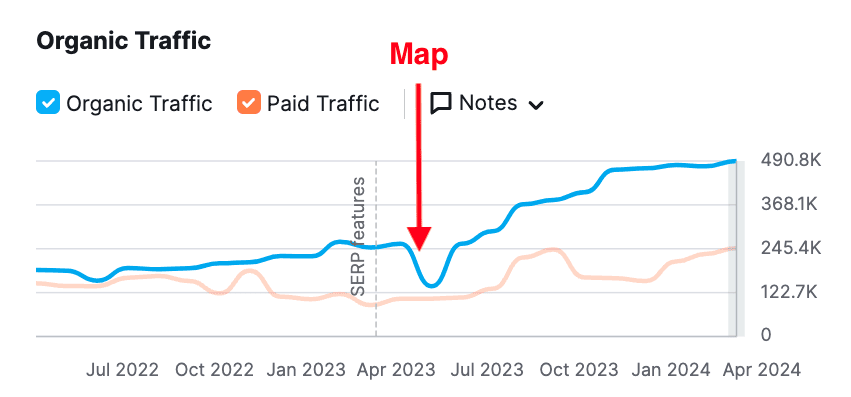
2. Topical Map Delivered – January 2023
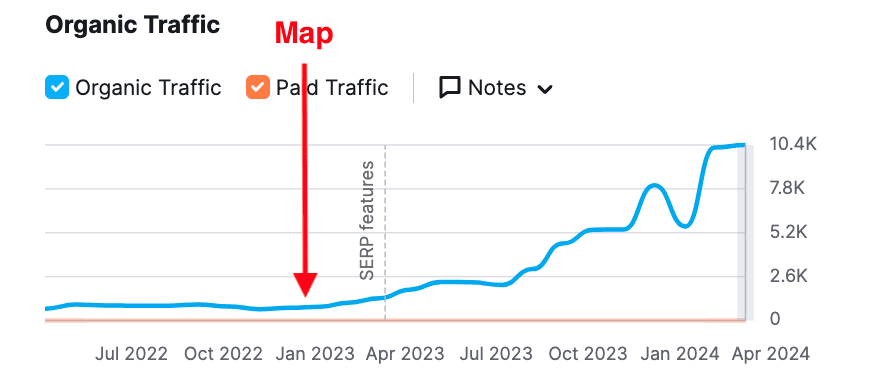
3. Topical Map Delivered – March 2023
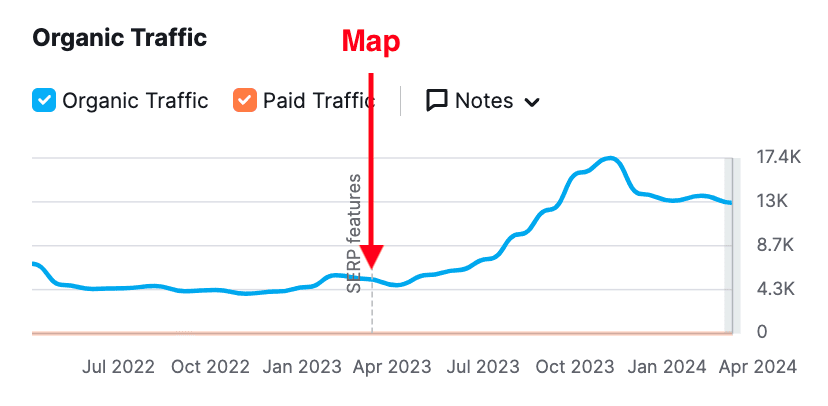
4. Two Topical Maps Delivered – February 2023 and October 2023
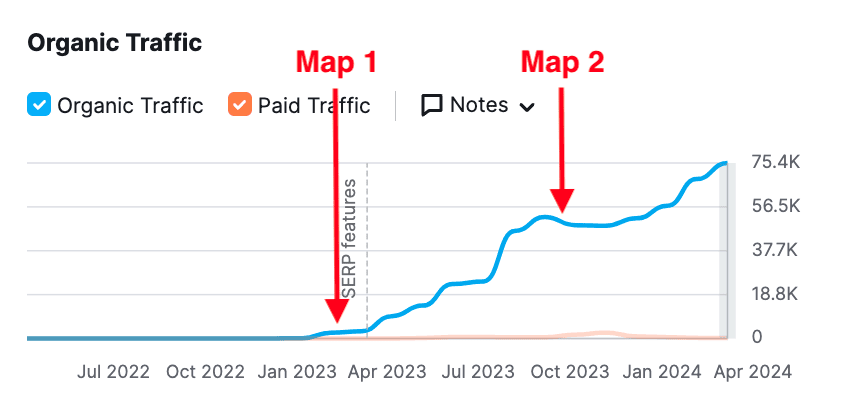
Join Hundreds of Other Topical Mappers
Learn how to create these blueprints to take your content strategy and planning to another level.
Join the Topical Maps Unlocked Course and Community now!
If you want a topical map done-for-you, we can take care of that with our topical map service!
Guide search engines and visitors through your site’s content, don’t make them figure it out – because they won’t. When done right, it boosts your site’s visibility and user experience. This powerful tool not only helps you meet your audience’s needs but also signals your expertise to search engines.

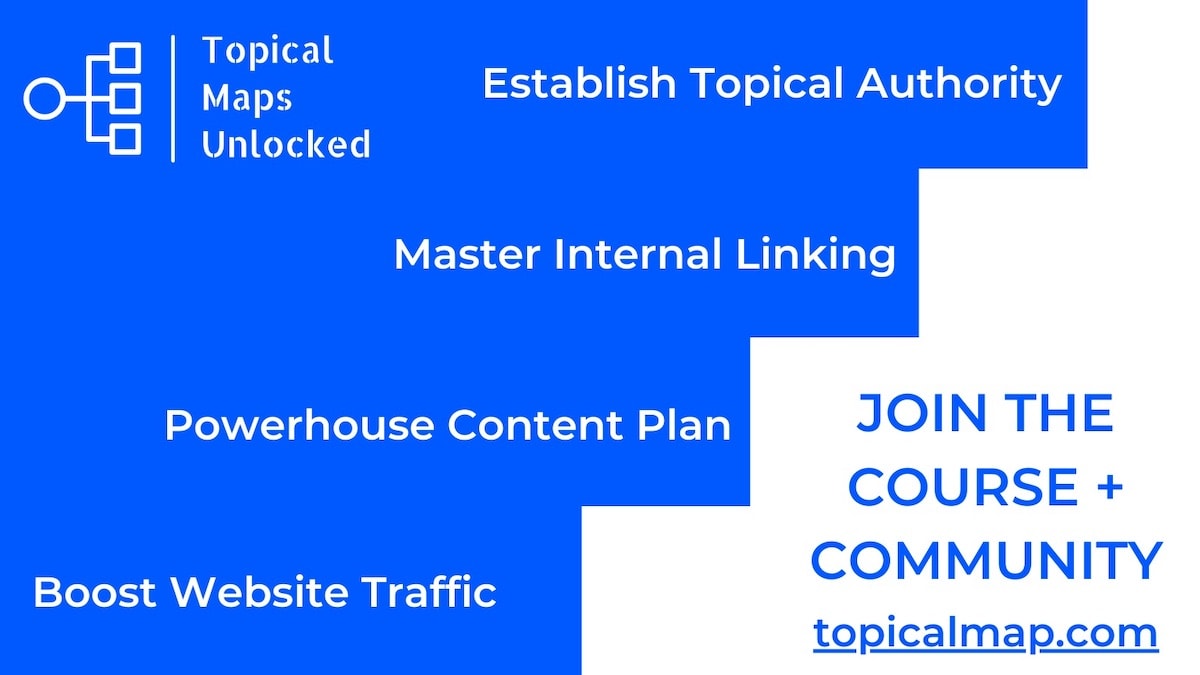

Hi Yoyao!
Do you have any client examples of where the client got hit with HCU but after doing a Topical map and rolling our content based on that topical map, they saw an improvement in their site traffic?
Hi Michelle!
When it comes to HCU, unfortunately, I haven’t seen any site recover specifically from it, client or not. But for clients, other than ‘niche sites’, I haven’t seen any get hit by the recent updates. The clients who followed the topical maps and strategies are all doing well 🙂